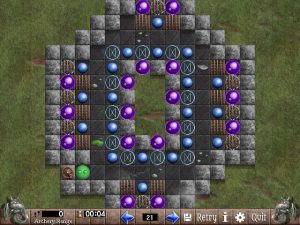Soko Banish has come a long way since 1.0. Websites changed; titles changed; presentation, graphics, and antiquated engine anomalies have been cleaned up. We have laughed, cried and possibly even expressed a feeling of complete indifference together. But throughout all this, one tumultuous tangle of chaos has persisted, indomitable… until now.
I’m talking about level order. When I created Soko Banish in 2006, I was mainly concerned with reaching my target amount of Standard levels, which happened to be 44 (giving the game 100 levels in total together with the Tutorial and conversions of the original Sokoban levels, which were included with the game prior to version 1.2). Since I was also impatient to release the game, this amounted to… well, untested and sometimes crudely designed levels. But more to the point of this article, it resulted in level numbering that was at best arbitrary, made worse by the inflexibility of organising level sets.
 |
| Whoops, I had my eyes closed. Can we Retry? |
Then, everything changed when the file nation attacked and lifted the requirement to number the files. Huzzah! In Soko Banish 1.4, levels can finally be given descriptive names – and you can even name them Fred. Their order is now alphabetical or defined in a file named levels.txt, which simply lists them all from top to bottom. (No relation to the deprecated file named levels.txt from older game versions. We don’t talk about that one.) And of course, I’m not letting this opportunity pass without finally rearranging the levels in the Standard set to reset your profile provide a more sensible progression to people who like to actually play things in order.
Unfortunately, this sounds a lot easier than it is (trust me, I listen to myself). In general, these were the things I considered in deciding on the new level order:
- The Difficulty. This one’s a no-brainer, though rather hard for me to determine by myself. What I did was write all the level names down in a text file and assign them numbers based on how complex I felt the solution was. As a handy side-effect, this has also helped me identify pitifully easy levels to improve, as well as any remaining unsolvable levels to disprove. (All levels have always been solvable. *waves hand* Always.)
- Skill themes. These aren’t necessarily very clear, as I didn’t really have them in mind when I first threw the game’s levels together, but to a more basic degree, elements and puzzle types recur throughout the set. Orbs, ghosts,
unsolvable soulstone arrangements,that sort of thing. My goal here, rather than keeping them together, was to keep them apart – it makes the set feel a lot more colourful, especially when the orbs are now purple. - And speaking of colours, Backgrounds. Soko Banish 1.4 introduces actual level background images in place of the ominous black void outside the boundaries of every stage. By default, this is now a black and blue void, but they can get as creative as a magic purple void or even some dirt. Unfortunately, this makes for a jarring effect when a unique-ish background repeats across multiple puzzles that are close to (or even directly next to) one another in the level sequence. Yes, levels are one very dysfunctional family, and these too had to be kept apart.
- Whatever the heck I felt like. In all seriousness, there was a certain sensation with some of the levels in which they only “felt” right when put into certain places (notably the “key” levels and the iconic Tower Bell stage) or a specific order. Determining this order sometimes involved reading their names aloud, traversing the rooms in sequence in my mind or contacting the spirits of my ancestors. Of course, I may just be going crazy, but the voices assure me that I’m not.
So what’s the best way to balance these? I’m not entirely sure, but I did find myself paying a lot less attention to the difficulty than I thought I would. Because at its heart, Soko Banish is a journey. A journey through disjointed rooms that by some unlikely chance contain Sokoban puzzles, but a journey no less. I feel that the game’s theme and potential for atmosphere – especially with the updated graphics! – is what offsets it from other Sokoban-like games (which may in other ways be more refined), and it’s something to foster.
Not coming soon: the potboiler novelisation.
